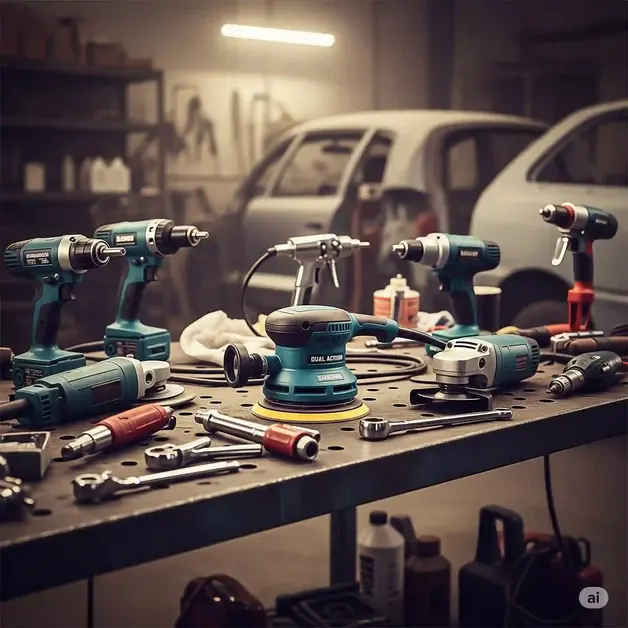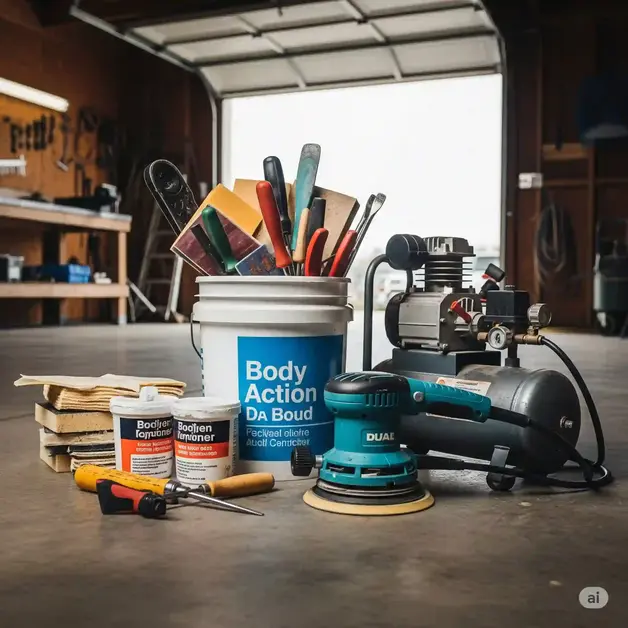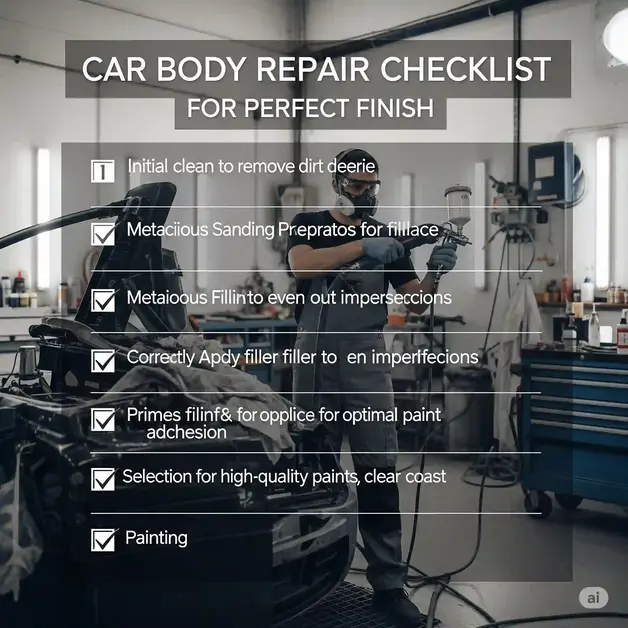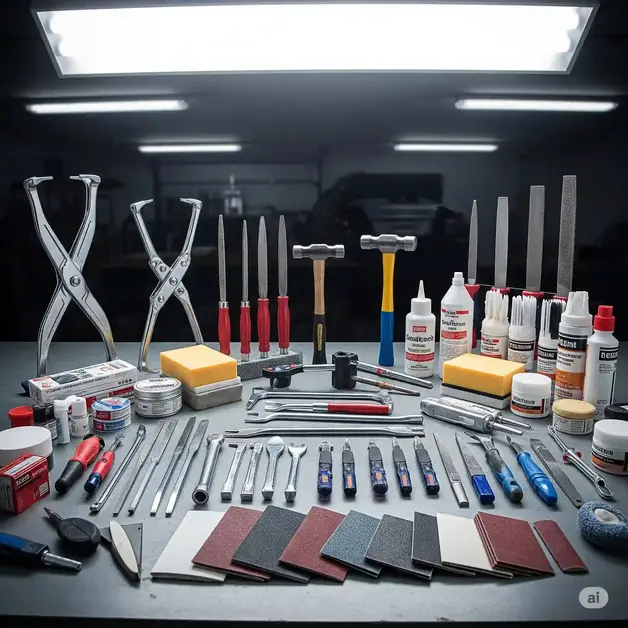I used to think fixing a dent or smoothing out a panel was a job only pros could handle—until I picked up my first set of car body tools. It wasn’t fancy gear, just basic stuff, but it completely changed how I saw DIY auto repairs. Over the years, I’ve tried and tested all kinds of body tools for cars, from cheap plastic spreaders to pro-level automotive body tools. If you’ve ever wondered where to start with car body repair tools, I’m here to walk you through it all. I’ll share what’s worked for me, what to avoid, and how to build your own setup without breaking the bank—whether you’re working out of a garage or a driveway.
Car Body Tools: What I Use to Repair and Restore Car Panels Like a Pro
When I first tried to fix a dent in my old car, I had no idea what I was doing. I grabbed a cheap rubber mallet from the local hardware store, a putty knife, and some off-brand filler. Let’s just say the result looked more like a lumpy pancake than a smooth panel. That’s when I realized how much car body tools matter—not just for a clean finish, but for saving time and frustration.
The truth is, you don’t need a giant tool chest to get started. Most of my early fixes were done with a handful of body car repair tools I could carry in one hand. What matters more is knowing which tools make the biggest difference. For example, a good sanding block and a decent filler spreader can turn a messy patch into something that actually blends in.
When you’re just starting, it’s tempting to grab whatever’s cheap. I’ve been there. But I quickly learned that even small upgrades—like switching from plastic to metal spreaders or investing in a quality dual action (DA) sander—help you get better results without spending hours fixing mistakes. It’s not about buying everything at once. It’s about building up your kit with tools that actually work.
Now, whether I’m working on a daily driver or a weekend project, I reach for the same trusted tools that helped me go from guessing to getting clean, smooth panels. These aren’t just automotive body tools—they’re tools that taught me patience, precision, and pride in my work.
So if you’re wondering how to get started with car body repair tools or want to improve your setup, stick with me. I’ll show you what’s in my kit, why I trust these tools, and how you can use them to tackle your own car body repairs—without feeling overwhelmed or overspending.
Why Having the Right Car Body Tools Matters
The first time I tried to fix a dent, I thought I could just “wing it” with a hammer and a cheap sanding pad. Big mistake. The dent got worse, the paint chipped off, and I ended up spending more time undoing my mess than actually fixing it. That day taught me something simple but powerful—having the right car body tools makes all the difference.
If you’re wondering whether to go DIY or buy pro-level tools, here’s the truth: you don’t need to buy everything a shop has. But some tools do make life easier. For example, a proper body hammer and dolly set helps you shape panels without leaving more damage behind. Even an affordable dual action sander can take hours off your sanding time and give you a smoother finish than hand sanding ever could.
I’ve tested both ends—super cheap and high-end. What I found is that it’s not about the price tag. It’s about using automotive body tools that match the job. A $20 filler spreader won’t beat a $3 one if it’s the wrong size or too stiff for the curve you’re working on. Knowing when and why to use the right tool? That’s what saves time and helps avoid frustration.
Every dent or repair I’ve done since that first disaster went smoother because I trusted the right tools—not luck. Whether you’re fixing a daily driver or working on an old project car, having the right car body repair tools makes you faster, more accurate, and way less stressed. Honestly, it’s like trying to cook with the wrong pan—it just doesn’t work well.
So, before you dive into bodywork, check your kit. Ask yourself: “Will this tool help me fix the problem, or create a new one?” It sounds simple, but that mindset alone saved me hours of sanding, re-filling, and repainting. Trust me—good body tools for cars aren’t a luxury. They’re your best friend when the metal fights back.
Essential Body Tools for Cars (Beginner to Intermediate)
When I first started working on my own car, I thought I could get by with just a hammer and some sandpaper. Turns out, bodywork takes a little more than elbow grease. If you’re just getting into this world, having the right car body repair tools really helps. It’s not about having everything—just having the right things for the job.
Body Hammers and Dollies
The first time I held a body hammer, I didn’t really know what to do with it. But once I paired it with a dolly and practiced on an old fender, it just clicked. These tools let you reshape metal without forcing it. A flat hammer is great for smoothing, while a curved or pick hammer is better for detailed shaping.
Each dolly has its own purpose too—flat ones for smoothing, curved ones for shaping, and toe dollies for tricky edges. If you’re new, grab a basic hammer-and-dolly set and just start tapping on scrap panels. Practicing on junk metal helps you feel the feedback—that’s when you start learning what the tool is really doing.
Sanding Tools and Blocks
I used to think any old sanding block would do. Then I tried a longboard block on a wavy panel and saw the difference. Block sanding helps you keep things flat and even, especially when you’re leveling filler or primer. Without it, you’ll probably end up chasing low spots with more filler—and I’ve done that too many times.
I keep three types of sanding blocks in my kit: flexible rubber blocks for curves, longboards for doors and fenders, and palm blocks for tight spots. For grits, I usually start with 80, move to 180, and finish with 320 before paint. Those three cover most jobs and keep your surfaces clean and consistent.
Filler Spreaders and Body Fillers
This is where a lot of people mess up—I sure did. My first attempt at applying filler looked like cake frosting. It was uneven and full of lines. What changed everything was switching to a better spreader and learning to mix the filler right. Using the right spreader gives you smoother application and less sanding later.
Metal spreaders are great for crisp edges, but plastic ones are easier to clean and shape around curves. I actually keep both on hand. As for fillers, I’ve had good luck with Evercoat and 3M. They’re easy to spread and sand, and they don’t gum up like the cheaper stuff.
Dent Pullers (Suction and Stud Welders)
Some dents can be pulled out in seconds. Others need more work. I started with a cheap suction cup puller. For shallow dents, it worked fine. But deeper creases and stretched metal? Not so much. That’s when I upgraded to a stud welder, and honestly, it changed the game.
Harbor Freight’s dent kits are a good place to start if you’re on a tight budget, but they have limits. If you’re serious about bodywork and plan to do it often, investing in a mid-range stud welder is worth it. It lets you pull metal from the inside out, which keeps the panel stronger and smoother.
If you’re just getting into automotive body tools, don’t stress about having everything at once. Start with a few key pieces: a hammer set, a couple of sanding blocks, a good filler, and a basic puller. You can do a lot with those. As you grow more confident, you’ll know exactly what tools you need next—because your work (and your mistakes) will show you.
Power Tools That Changed My Body Work Game
There’s a point in every DIY journey when hand tools just aren’t enough. I remember the day I tried sanding a full fender by hand—it felt like I aged five years in one afternoon. That’s when I realized power tools aren’t just helpful—they’re a must if you want clean, pro-level results without spending hours breaking your back. The right ones don’t just save time—they save your patience.
Dual Action (DA) Sander
If you only buy one power tool for bodywork, make it a DA sander. I used to prep panels by hand until a buddy handed me his old DA, and within minutes, I was sold. It sands smooth, doesn’t leave swirl marks if you use it right, and it’s surprisingly easy to control. A DA sander speeds up sanding and gives a cleaner finish, especially on curved or large panels.
I use a 6-inch model with a variable speed dial—low speed for finishing, higher for knocking down filler or primer. Stick to quality sanding discs (I like 3M or Norton) and switch grits as you go—usually starting at 80, then 180, then 320 for finish prep. Trust me, your arms will thank you.
Air Tools (Grinders, Drills, and Ratchets)
Air tools might sound intimidating, but once you try them, you won’t go back. I started with a small compressor and a basic air ratchet. The torque and control were a game-changer, especially when working in tight engine bays or under fenders. For bodywork, die grinders and cut off wheels make trimming or shaping metal way easier—but wear good gloves and eye protection. Those sparks are no joke.
One thing I learned early: don’t cheap out on airline fittings or hoses. Air leaks will drive you nuts, and poor airflow kills performance. I use my die grinder with a 3-inch cutoff disc for cutting rusted panels or shaving down welds. It’s loud and dusty, but it beats hand tools by a mile.
When do I choose air over cordless? For heavy-duty jobs or when I’m working non-stop on a project. Cordless tools are great too—especially for drills and screw guns—but compressed air gives me constant power with no charging delays. Air tools offer speed and strength without the weight of bigger electric tools, which really helps when working overhead or for long sessions.
If you’re building out your car body tool kit, power tools don’t have to be fancy or expensive. I built mine slowly, starting with a DA sander, then adding air tools over time. Look for used deals at swap meets or online. With just a few solid tools, you can work faster, cleaner, and actually enjoy the process. That’s when bodywork becomes fun—not just functional.
Automotive Body Tools I Keep in Every Project Kit
Over the years, I’ve built up a kit of car body tools that I keep within arm’s reach on every project—whether I’m working on a rusty fender or just popping out a trim panel. These aren’t just tools I use once in a while. These are my go-to, grab-it-every-time tools that save me time, stress, and guesswork. If you’re starting your own kit, this list will help you figure out what’s actually worth keeping close by.
Trim Tools and Panel Removers
If you’ve ever tried removing a door panel with a flathead screwdriver, you probably know how easy it is to snap a clip—or gouge the paint. I learned that lesson the hard way when I cracked a plastic panel on my old Civic. That’s when I picked up a basic set of trim removal tools. They’re cheap, usually under $15, and they save you from breaking delicate clips or scratching your finish.
Short answer: Trim tools let you remove panels cleanly without breaking clips or scratching surfaces.
I keep both plastic and metal ones in my bag. The plastic ones are great for dashboards and door panels, while the metal ones help with stubborn fasteners under the hood or in tight trunk corners. If you do any interior or trim work, don’t skip these.
Tin Snips and Aviation Shears
Cutting sheet metal sounds simple—until you’re trying to get a clean edge on a patch panel. I started with old kitchen scissors (not proud), then quickly learned the power of proper tin snips. Aviation shears, in particular, are a game changer. They cut through steel like butter and give you way more control over curves and tight cuts.
Short answer: Tin snips and aviation shears make cutting sheet metal fast, clean, and accurate.
I use red (left cut), green (right cut), and yellow (straight cut) shears depending on the direction of the line. For rust repair or cutting out damaged metal, this is one of those tools that’s worth spending a bit more on.
My Go-To Screwdriver and Socket Sets
I didn’t realize how many fasteners cars had until I started tearing one down. From bumpers to interior panels, you’ll constantly run into screws, bolts, and odd little clips. That’s why I always keep a full screwdriver set—flathead, Phillips, and Torx—as well as a decent socket set with metric and SAE sizes.
Short answer: A complete screwdriver and socket set lets you remove and reinstall parts without stripping bolts or searching for tools.
You don’t need to go snap-on fancy, either. I’ve used my mid-range Craftsman set for years, and it’s still going strong. Look for magnetic tips on screwdrivers and a ratchet with a smooth throw—it makes a difference when you’re working in tight spots.
Spoon Tools and Their Hidden Uses
Not a lot of people talk about spoon tools, but they’re surprisingly useful. I first picked one up for dent work, but now I use it for everything from tapping out small creases to smoothing filler edges. It’s like a body hammer’s quieter cousin—more finesse, less force.
Short answer: Spoon tools are great for smoothing dents and blending edges where precision matters more than power.
They work best when paired with a dolly behind the panel. For spots where a hammer is too aggressive or where you’re working on a gentle curve, a spoon gives you control without causing more damage. I keep one in my kit at all times, and it’s saved my skin more than once.
These are the tools I always come back to—no matter the project. They’re not flashy or expensive, but they get the job done. When you’re building your own car body repair tool kit, start with the stuff you’ll actually use again and again. That’s how I built mine—one tool at a time, based on real needs and real mistakes.
What You Need for Paint and Finishing Work
Once the dents are gone and the filler’s smooth, it’s time for the part that either makes your work shine—or exposes every mistake: painting and finishing. I used to think this was the easy part. Just spray and done, right? Nope. This stage is where details matter the most. If you’re wondering what auto body supplies you really need to get that smooth, factory-like finish, let me walk you through what’s worked for me—and what didn’t.
Paint Guns and Compressor Setup
The first time I picked up a paint gun, I had no idea what I was doing. I bought a super cheap gun online and thought it would be “good enough.” Big mistake. The finish came out blotchy, I got runs in the clear coat, and the compressor kept struggling to keep up. That job taught me two things: good paintwork needs decent gear, and air pressure really matters.
Short answer: A reliable paint gun and compressor setup ensures even coverage and reduces paint flaws like runs and orange peel.
Now, I use a mid-range HVLP spray gun paired with a 20–30 gallon compressor. It doesn’t have to be top-shelf, but it should have enough CFM to keep up with your gun. I learned to adjust my air pressure based on the type of paint—usually around 25–30 PSI at the gun. For clear coat, I sometimes drop it slightly to reduce overspray. Most of my success came from simply practicing on scrap panels and dialing in the settings before touching a real project.
I also switched to using disposable paint cups and inline moisture traps. Sounds minor, but it keeps your lines clean and reduces the chance of water spitting into your paint job. It’s these small tweaks that make a big difference.
Seam Sealers, Tapes, and Other Finishing Supplies
Before I got serious about finishing, I thought masking tape was just… tape. But when you’ve spent hours prepping a panel, the last thing you want is paint bleeding under cheap masking or sealant that doesn’t cure right. I’ve learned to treat finishing supplies as essential—not extras.
Short answer: Quality seam sealer, tape, and finishing products protect your work and make the paint last longer.
For seams and welded joints, I always run a thin line of brush able seam sealer—especially in wheel wells or rocker panels. It keeps out moisture and prevents rust from creeping back in. I use 3M or SEM sealers because they go on smooth and stay flexible after drying.
When it comes to masking, I now only use automotive-grade tape and paper—not newspaper, not whatever’s in the drawer. Cheap tape peels off primer or leaves residue, and once you’ve had to redo a job because of bad edges, you never go back.
I also keep a set of tack cloths and panel wipes nearby to clean the surface right before painting. Any dust or fingerprints you leave behind will show up under the clear like a spotlight.
At first, I thought paint and finishing work was about the paint itself. But it’s really about preparation, protection, and patience. You don’t need to spend thousands, but you do need to pay attention to the little things—like air pressure, seam sealing, and clean lines. That’s what turns a decent repair into one you’re actually proud to show off.
If you’re building out your auto body supplies kit, start with a good spray gun, solid compressor, and quality masking materials. Don’t cut corners here—because this is where the final impression lives. And nothing beats the feeling of seeing your panel dry smooth and clean, knowing you did that.
How to Build Your Own Car Body Repair Tool Kit on a Budget
When I first got into bodywork, I thought I needed a full garage setup with thousands of dollars’ worth of tools. Truth is, you can do a lot with a small budget—as long as you choose smart. If you’ve got the drive to learn, I’ll show you how to build a solid car body repair tool kit without emptying your wallet. All it takes is a little planning and knowing where to shop.
Short answer: You can build a beginner-friendly car body repair kit for under $300 by starting with essential tools and buying smart.
Tools That Fit in a 5-Gallon Bucket
I started with what I could carry in one hand. Literally. A hammer and dolly set, sanding blocks, filler spreaders, and a cheap suction puller—all fit in an old paint bucket. That bucket was my first mobile body shop, and I still keep it around for quick jobs.
Short answer: The most useful starter tools for DIY body repair can easily fit in a 5-gallon bucket.
Here’s what mine held at the start:
- 3-piece body hammer and dolly set
- Flexible and rigid sanding blocks
- Plastic and metal filler spreaders
- A quart of quality body filler
- A basic suction dent puller
- Masking tape and gloves
You don’t need to start big. You need to start practicing. That’s the key.
Where I Shop: Harbor Freight, Amazon, and Craigslist Finds
If you’re on a budget, don’t underestimate where you shop. Harbor Freight became my go-to for tools I needed right away—like hammers, air tools, and sanding gear. Are they pro-level? Not always. But for learning, practicing, and light repairs, they’re more than enough.
Short answer: Harbor Freight, Amazon, and Craigslist are great places to find affordable body tools, especially for beginners.
Amazon is my backup for name-brand stuff—especially sanding discs and fillers I trust, like 3M and Evercoat. Craigslist and Facebook Marketplace? Gold mines. I once scored a barely-used DA sander and air compressor for under $100 just because someone was clearing out a shed.
It’s all about checking often and knowing what a good deal looks like.
Tips for Buying Used Tools That Last
Buying used can save you a ton—but it’s also where mistakes happen if you’re not careful. I learned to check for rust, test moving parts, and avoid anything missing key pieces. And if you’re buying an air tool or compressor, always ask to see it run. If it sounds weird, walk away.
Short answer: Always inspect used tools closely and test before buying to avoid getting stuck with junk.
Stick with brands that have spare parts or wide support. Even if a tool’s old, if it’s from a solid brand, you can usually fix it or replace pieces when needed.
Start Small: My $300 Setup for Beginners
Want a realistic setup that doesn’t break the bank? Here’s what I’d recommend if I had to start all over again with just $300:
- $30 – Hammer and dolly set
- $20 – Sanding block kit (includes longboard + flexible blocks)
- $25 – Plastic & metal spreaders
- $40 – 1 qt Ever coat filler + hardener
- $40 – Suction dent puller or slide hammer kit
- $50 – Harbor Freight DA sander
- $70 – Used 20–30 gal compressor (Craigslist/Marketplace)
- $25 – Masking tape, gloves, and tack cloths
Short answer: You can start bodywork for under $300 with smart purchases and a focus on core tools.
It’s not about having every tool—it’s about having the right tools to learn, fix, and build confidence. Over time, you’ll add more as your skills (and projects) grow. But this setup will carry you through most common repairs and teach you everything that matters.
If you’re just getting into body repair, don’t let the tool aisles or price tags scare you. I’ve done solid panel repairs with nothing more than what fit in a bucket and the patience to practice. Start small, spend smart, and let your results do the talking. That’s how every real DIYer begins.
Real Lessons I Learned Doing Body Work at Home
I’ve learned more from messing up in my driveway than from any guide or YouTube video. Doing car body work at home taught me real lessons—sometimes the hard way—but every dent, drip, or sanding mishap made me better. If you’re just starting, these lessons might save you hours of stress (and maybe a few curse words too).
Short answer: The biggest bodywork lessons come from trial and error—and learning at home makes you more hands-on, patient, and creative.
The First Panel I Ruined—and How I Fixed It
I’ll never forget the first time I tried to fix a rusty rear quarter panel on my old Civic. I thought I could sand, patch, and fill it in one afternoon. By evening, the panel was lumpy, the filler had hardened mid-spread, and I had sanding dust everywhere—even in my ears.
Short answer: Rushing a repair usually leads to more work later. Take your time and follow the process step by step.
Instead of getting mad, I stopped, sanded it all off, and started again the next weekend. That one mistake taught me patience. And that patience? It shows in every clean repair I do now.
Learning to Weld on Scrap Before Touching a Car
When I bought my first cheap flux-core welder, I was ready to start patching rocker panels the same day. Big mistake. My welds looked like bubblegum and blew holes through the metal. That’s when I grabbed an old washing machine panel and just practiced—again and again.
Short answer: Always practice welding on scrap metal first—never on the car you’re trying to save.
I learned how heat affects sheet metal, how to control my wire speed, and when to back off. It took time, but now I can confidently weld thin patches without warping the whole panel. Practice makes perfect, and scrap metal is your best friend.
Time-Saving Hacks I Wish I Knew Sooner
There were little things I didn’t learn until way too late. Like how spraying guide coats before sanding helps you spot high and low areas fast. Or how mixing just enough filler for one application saves waste (and panic).
Short answer: Small tricks—like guide coat, mixing small filler batches, or keeping tools prepped—save big time during bodywork.
Even something as simple as using magnets to hold a patch panel while taking it in place changed the game for me. I used to fight with clamps in weird positions—now I just snap a few magnets on and weld stress-free.
Bodywork at home isn’t about perfection—it’s about progress. You’ll make mistakes, get dusty, and probably rethink your life mid-sanding session. But each lesson adds up. And when you finally stand back and look at a smooth, primed panel that you repaired in your own driveway? That’s a feeling no money can buy.
So don’t be afraid to mess up. Just make sure you learn from every slip-up, and let those lessons guide your next repair. That’s how real skills are built—panel by panel, right at home.
 FAQs About Car Body Tools
FAQs About Car Body Tools
What tools do I need to fix a dent in my car?
To fix a dent, you’ll need a body hammer, dolly, filler, sandpaper, and either a suction puller or stud welder—based on how deep the dent is.
What is the best tool to use for body filler application?
The best tools for applying body filler are plastic or metal spreaders. Plastic is easier for beginners, while metal gives a smoother, sharper finish.
Can I do auto body work at home with basic tools?
Yes, you can. With hammers, sandpaper, filler, and a DA sander, you can handle small dent repairs and paint prep right in your driveway.
What tools do professionals use in auto body repair?
Pros use body hammers, stud welders, DA sanders, paint guns, air tools, and panel beaters to repair dents, sand smooth, and finish body panels.
Where can I buy affordable body tools for cars?
You can find budget car body tools at Harbor Freight, Amazon, and even local sellers on Craigslist or Facebook Marketplace.
Final Thoughts – Start Small, Stay Consistent, Keep Learning
If you’re someone who loves working with your hands and enjoys learning by doing, car body repair can be incredibly rewarding. These tools and tips are perfect for DIYers who don’t mind getting a little dirty and making a few mistakes along the way. But if you want quick, flawless results without the trial-and-error, you might be better off leaving it to a shop.
Honestly, I’ve learned more from my messed-up panels than from perfect ones. The key is to start small, stay consistent, and never stop learning. Every pro was once a beginner staring at a dent, wondering where to start—and now, so are you.

